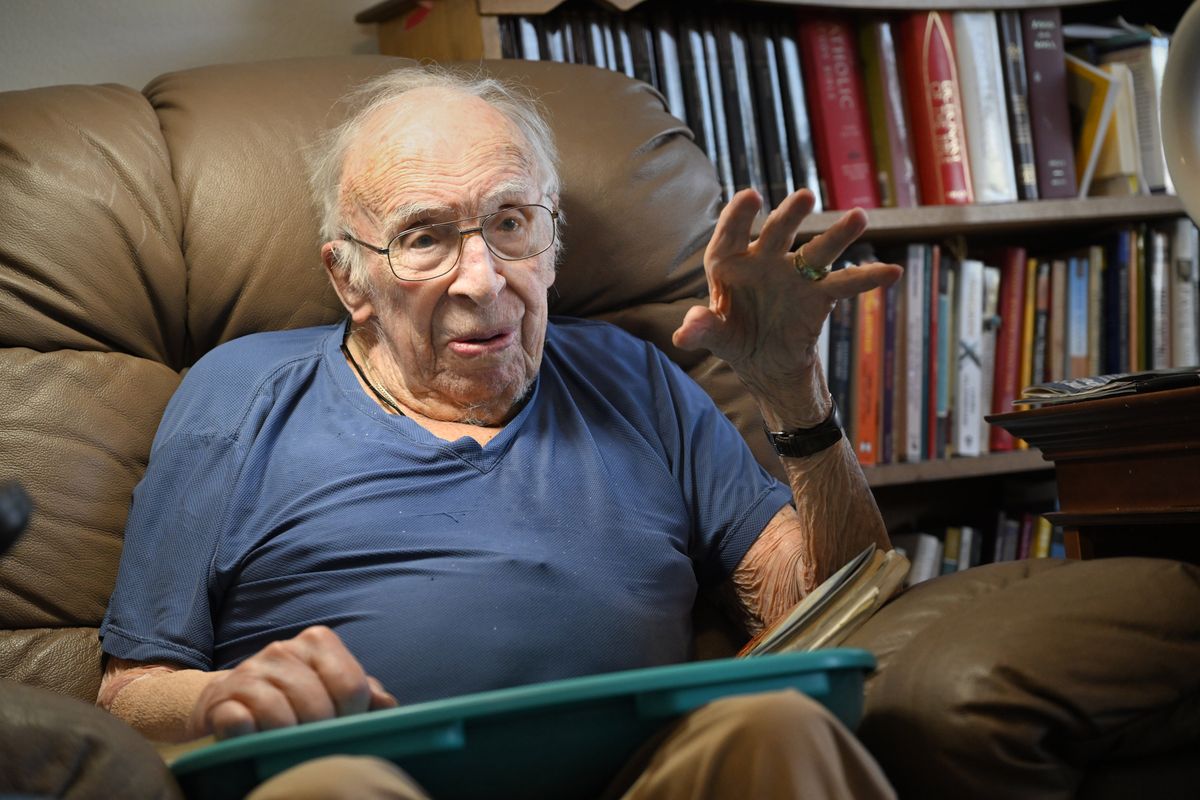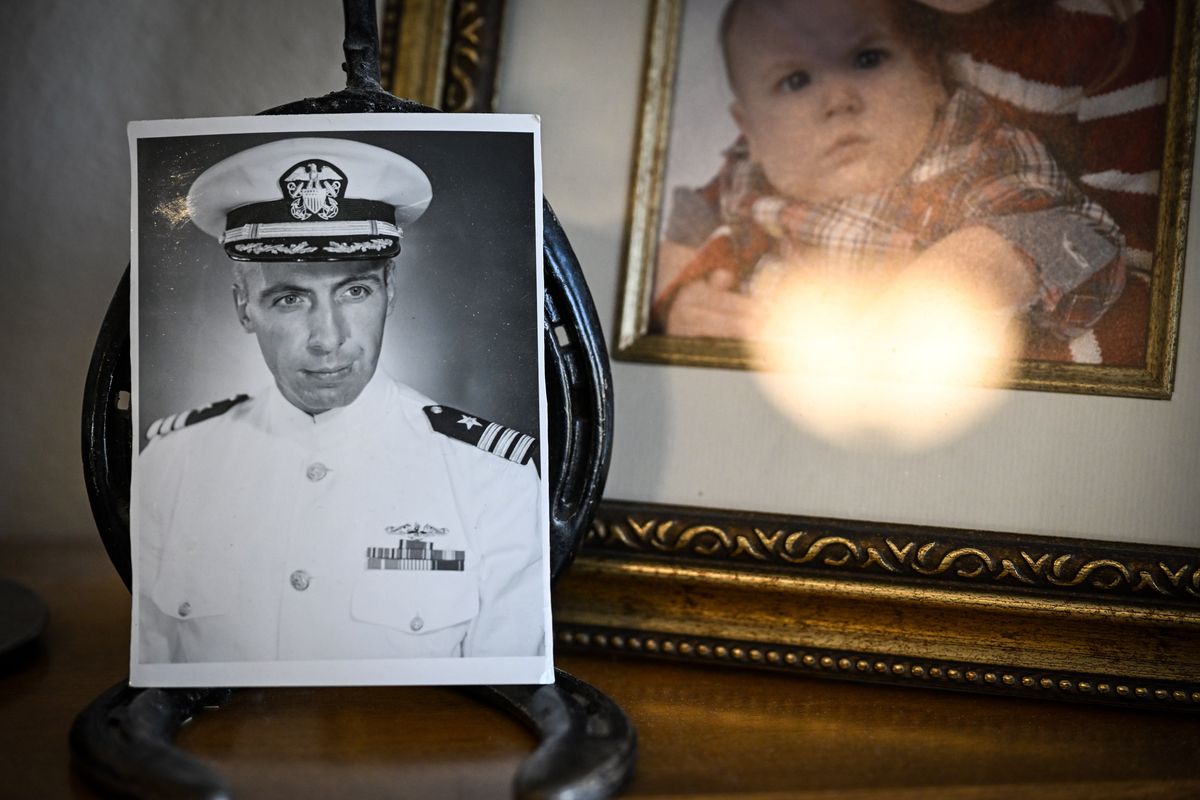Engineer who helped usher U.S. Navy into nuclear age turns 101: ‘I’ve got so much to be thankful for’
Frank Fogarty, sitting in his apartment in a Spokane retirement center, talks about his life over his 101 years on Friday, including many as a U.S. Navy officer. He was one of the first captains of a U.S. Navy nuclear submarine, appointed by Admiral Hyman Rickover. (Jesse Tinsley/THE SPOKESMAN-REVIEW)
The bottle of Jameson Irish Whiskey on the counter was a birthday gift from one of his 10 children. It’ll last Frank Fogarty, a one-drink kind of guy, a while.
He’s someone who’s made a habit of making things last. Fogarty turned 101 on Friday.
“I don’t think about it,” he said while laughing about his age from his home at South Hill Village in Spokane. “The doctors say I should take a little bit of credit because I’ve been active all my life. It’s got a lot to do with your heredity.”
The eyes are a bit clouded, and Fogarty admittedly struggles sometimes with names and exact dates, but the former nuclear engineer has lost nothing of his ability to tell a story.
And his tale is that of atomic engineering, first with the U.S. Navy and later with commercial power plants.
Born in Great Falls, Fogarty enlisted to join the Navy during World War II. But because he already had a year of college, his superiors instead kept him in school so that he could later attend the U.S. Naval Academy.
After graduating from the academy in 1948, Fogarty first served on ships, including a stint on an aircraft carrier, and another aboard the USS Iowa battleship.
But his destiny led him to the “Silent Service,” the crews who operated beneath the waves on submarines.
Fogarty attended submarine school in 1950 and served on two Balao-class diesel boats, the USS Tiru and the U.S.S Queenfish, for three years during the Korean War.
The captain of the Tiru at the time was Patrick Gray, who later became President Richard Nixon’s choice to replace J. Edgar Hoover as the director of the FBI. However, Gray withdrew his name from consideration after being implicated in the Watergate investigation.
While serving during the war in Korea, Fogarty in 1953 was selected to interview to serve under Adm. Hyman Rickover, who directed the development of naval nuclear propulsion.
Rickover personally picked over the test results and questioned the candidates on those areas where they seemed the weakest, Fogarty said.
About three months after the interviews, Fogarty returned to his submarine, which pulled into port at Yokasuka, Japan. The captain on the submarine next to them yelled over: “ ‘I understand that you got a Rickover guy on your ship. He picked Fogarty.’ So they flew us back to Hawaii.”
Fogarty then gathered his wife, Dorothy, whom he married in 1948, and their young family moved to upstate New York.
“Me and three other guys were the first engineers on a nuclear submarine, the Seawolf,” he said. “The senior one of us was a year ahead of me at the Naval Academy – a fella named Jimmy Carter.”
Fogarty worked directly with the future president, under Rickover’s supervision, to bring the U.S. Navy into the nuclear age.
“Jimmy’s dad died,” Fogarty said. “So, his mother made him quit the Navy and go back to Georgia. You know what happened to him after that. So, he did pretty well.”
Fogarty then served on the crew that took the USS Seawolf out to sea for the first time in 1955. He was later transferred to the USS Nautilus, which had been operating for about a year.
“We were learning every day. We were doing something that nobody had done before,” he said. “It was kind of an exciting time.”
But the novel science behind the shift to nuclear power also suffered casualties.
The captain of the nuclear submarine USS Thresher, which was also the name of an earlier submarine that served in World War II, was Lt. Cmdr John Wesley Harvey, who earlier had worked as an engineer on the nuclear program with Fogarty.
The Thresher sank in April 1963 while undergoing sea trials.
Fogarty later personally selected Cmdr. Francis A. Slatterly, who had served as his executive officer, to lead the USS Scorpion. It sank in May 1968, and all 99 crew members on board were lost to the depths of the Atlantic Ocean.
“So, I had those two close friends that I knew who got lost on submarines,” Fogarty said. “I knew a lot of the enlisted and other wardroom people on those ships.”
Fogarty later was promoted to executive officer and eventually was made captain of the Nautilus. While serving on the Nautilus, Fogarty was part of a second attempt that finally reached the North Pole under the sea ice.
“I was the commanding officer for three-and-a-half years of the Nautilus,” he said. “I went from there the chief of naval operations staff in Washington. I retired from there because I had eight kids. The oldest were ready for college, and I couldn’t afford to send them to college on Navy pay.”
After 27 years in the Navy, Fogarty retired as a captain and took a job running three nuclear plants outside Idaho Falls at the Idaho National Engineering and Environmental Laboratory. He worked there for 20 years before retiring a second time.
“That’s when they shut down all the nuclear commercial plants because of the problems in Pennsylvania with the Three Mile Island” plant in 1979, he said. “So I was in charge of an independent group that analyzed why that happened and what to do about it before they started up the nuclear program again in the Navy.”
He then went to Tennessee and ran the Tennessee Valley Authority’s five nuclear plants.
“I helped them get started after being shut down,” he said.
After leaving INEEL, he started a coal-fired electromagnetic power plant in Butte, Montana. But the plant shut down after two years when the technology proved unworkable.
He then “retired” to 40 acres north of Idaho Falls, where the nuclear engineer traded neutrons for barbed wire.
“I had fun raising some beef cattle. I had some good friends who taught me how to be a rancher, because I was not that qualified, even though I had grown up in Montana,” he said.
Dorothy died in 2015. The couple had been together for 68 years.
Along with 10 children, Fogarty has 21 grandchildren and 12 great-grandchildren.
Two of Fogarty’s grandchildren live in Spokane, which is how he ended up here, he said.
Fogarty noted that his mother lived until age 96. His father died at age 67, but his death occurred during surgery to remove his appendix. Fogarty’s father’s brothers both lived into their 90s.
Except for the occasional beer, and Irish whiskey, Fogarty said he never smoked or formed other bad habits that hurt his health.
“Oh yeah, of course I’m glad,” he said when asked about his longevity. “All my kids are close to each other. Our family is as close as the dickens.
“I’ve got so much to be thankful for,” Fogarty continued. “There is something new happening all the time.”

